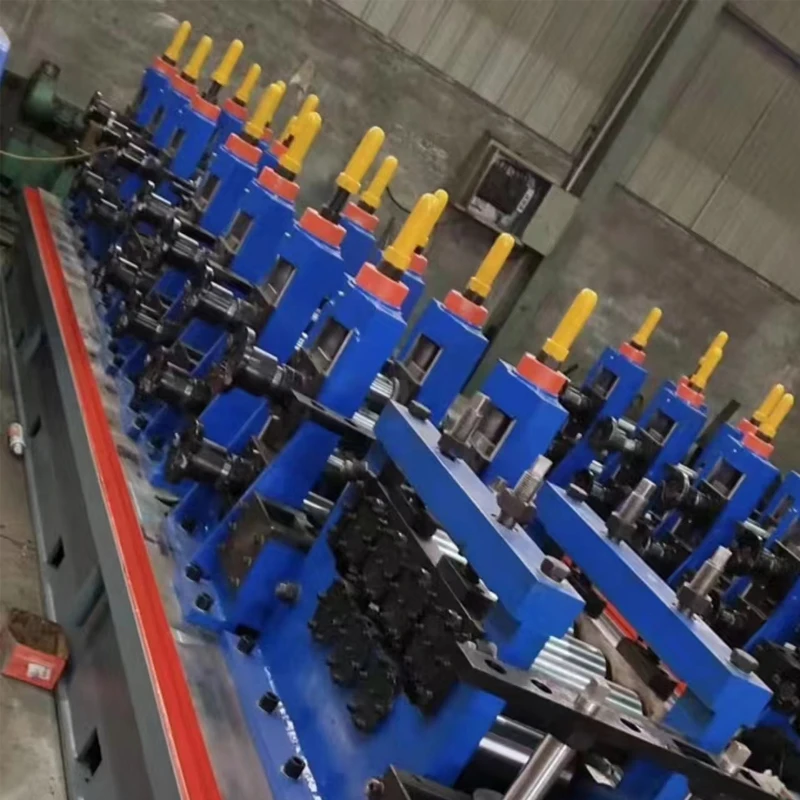silo roll forming machine
The Silo Roll Forming Machine An Overview
In the realm of modern manufacturing, efficiency and precision are paramount. One piece of equipment that embodies these traits is the silo roll forming machine. This innovative machine is designed specifically for the production of silos, which are essential for storing bulk materials such as grain, feed, and other agricultural products. With increasing demands in agriculture and industry for effective storage solutions, the role of silo roll forming machines has become more significant than ever.
What is a Silo Roll Forming Machine?
A silo roll forming machine is a specialized piece of equipment that employs a series of rollers to form sheets of metal into the desired shape for constructing silos. The process involves feeding a flat strip of metal into the machine, where it passes through multiple sets of rollers. Each set gradually shapes the metal until it forms the cylindrical structure required for silos. This method ensures that the metal is bent uniformly, resulting in a high-quality finished product.
Key Features and Benefits
1. Efficiency One of the primary advantages of a silo roll forming machine is its efficiency. With the capacity to produce long lengths of material continuously, these machines can significantly reduce production time compared to traditional methods of silo construction.
2. Precision and Customization Silo roll forming machines offer a high degree of accuracy and customization. Operators can adjust the settings to produce silos of various sizes and dimensions, catering to specific storage needs. This flexibility is crucial for industries that require specialized storage solutions.
3. Material Versatility These machines can work with different types of metals, including galvanized steel, stainless steel, and aluminum. This versatility allows manufacturers to choose materials based on the environmental conditions the silos will face, ensuring durability and longevity.
4. Cost-Effectiveness By minimizing wastage and maximizing efficiency, silo roll forming machines contribute to cost savings in production. The ability to produce large volumes of material quickly means that manufacturers can meet market demands without incurring unnecessary expenses.
silo roll forming machine

5. Automation and Ease of Use Modern silo roll forming machines are equipped with advanced automation systems that enhance their usability. Operators can manage the entire process with minimal manual intervention, reducing the risk of human error and ensuring a consistent quality of production.
Applications of Silo Roll Forming Machines
Silo roll forming machines are used in various industries beyond agriculture. While they are primarily associated with grain storage, they are also employed in sectors such as
- Feedstock Storage Livestock farmers use silos to store feed, ensuring it remains dry and free from pests. - Waste Management Silos can be used to store industrial byproducts and waste materials, providing an organized solution for waste management. - Bioenergy Silo storage is crucial for the agricultural industry, where biomass fuels are stored for later processing and energy generation.
Conclusion
The silo roll forming machine exemplifies the evolution of manufacturing technology, addressing the growing needs of various industries for efficient and reliable storage solutions. By leveraging the benefits of precision, efficiency, and customization, these machines play a vital role in both agricultural and industrial sectors.
As the world continues to shift towards more sustainable practices and efficient storage solutions, the demand for silo roll forming machines is likely to increase. Manufacturers that invest in this technology will be better positioned to meet the evolving needs of the market, providing high-quality products that contribute to their customers' success.
In summary, the silo roll forming machine is not merely a tool; it represents a significant advancement in how industries approach storage, sustainability, and production efficiency. As technology continues to progress, so too will the capabilities of these machines, solidifying their importance in the future of manufacturing.
-
High Frequency Straight Seam Welded Pipe Production Line|BzZhou Xinghua|Precision Welding&EfficiencyNewsJul.30,2025
-
High Frequency Straight Seam Welded Pipe Production Line - BzZhou Xinghua|Precision Engineering&EfficiencyNewsJul.30,2025
-
High-Frequency Straight Seam Welded Pipe Production Line-BzZhou Xinghua Machinery Equipment Manufacturing Co., LTD.NewsJul.30,2025
-
High-Frequency Straight Seam Welded Pipe Production Line-BzZhou Xinghua Machinery Equipment Manufacturing Co., LTD.|Precision Manufacturing, High EfficiencyNewsJul.30,2025
-
High Frequency Straight Seam Welded Pipe Production Line-BzZhou Xinghua Machinery Equipment Manufacturing Co., LTD.|Precision Steel Pipe Manufacturing&Industrial EfficiencyNewsJul.29,2025
-
High-Frequency Straight Seam Welded Pipe Production Line-BzZhou Xinghua Machinery Equipment Manufacturing Co., LTD.|Precision Steel Pipe Manufacturing&Industrial EfficiencyNewsJul.29,2025


